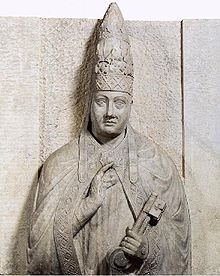
In the Middle Ages, hierocracy or papalism[n 1] was a current of Latin legal and political thought that argued that the pope held supreme authority over not just spiritual, but also temporal affairs. In its full, late medieval form, hierocratic theory posited that since Christ was lord of the universe and both king and priest, and the pope was his earthly vicar, the pope must also possess both spiritual and temporal authority over everybody in the world.[1][2] Papalist writers at the turn of the 14th century such as Augustinus Triumphus and Giles of Rome depicted secular government as a product of human sinfulness that originated, by necessity, in tyrannical usurpation, and could be redeemed only by submission to the superior spiritual sovereignty of the pope.[3] At the head of the Catholic Church, responsible to no other jurisdiction except God, the pope, they argued, was the monarch of a universal kingdom whose power extended to Christians and non-Christians alike.[4]
The hierocrats limited their extensive conception of the pope's authority by acknowledging that the day-to-day exercise of temporal power belonged, in general, to secular princes, albeit under the guidance of the pope. Hierocracy was criticised at the time from a pro-royal perspective by John of Paris, in defence of the universal monarchy of the Holy Roman emperor by Dante Alighieri, and by critics of papal supremacy over the Catholic Church itself such as Marsilius of Padua. Though hierocracy continued to influence papal policy until the time of the Reformation, by the 17th century the doctrine was generally rejected by Catholic theologians.
Cite error: There are <ref group=n> tags on this page, but the references will not show without a {{reflist|group=n}} template (see the help page).
- ^ McCready 1973, pp. 659–60.
- ^ Sisson 2016, p. 131.
- ^ McCready 1973, p. 665.
- ^ Sisson 2016, pp. 122–23.